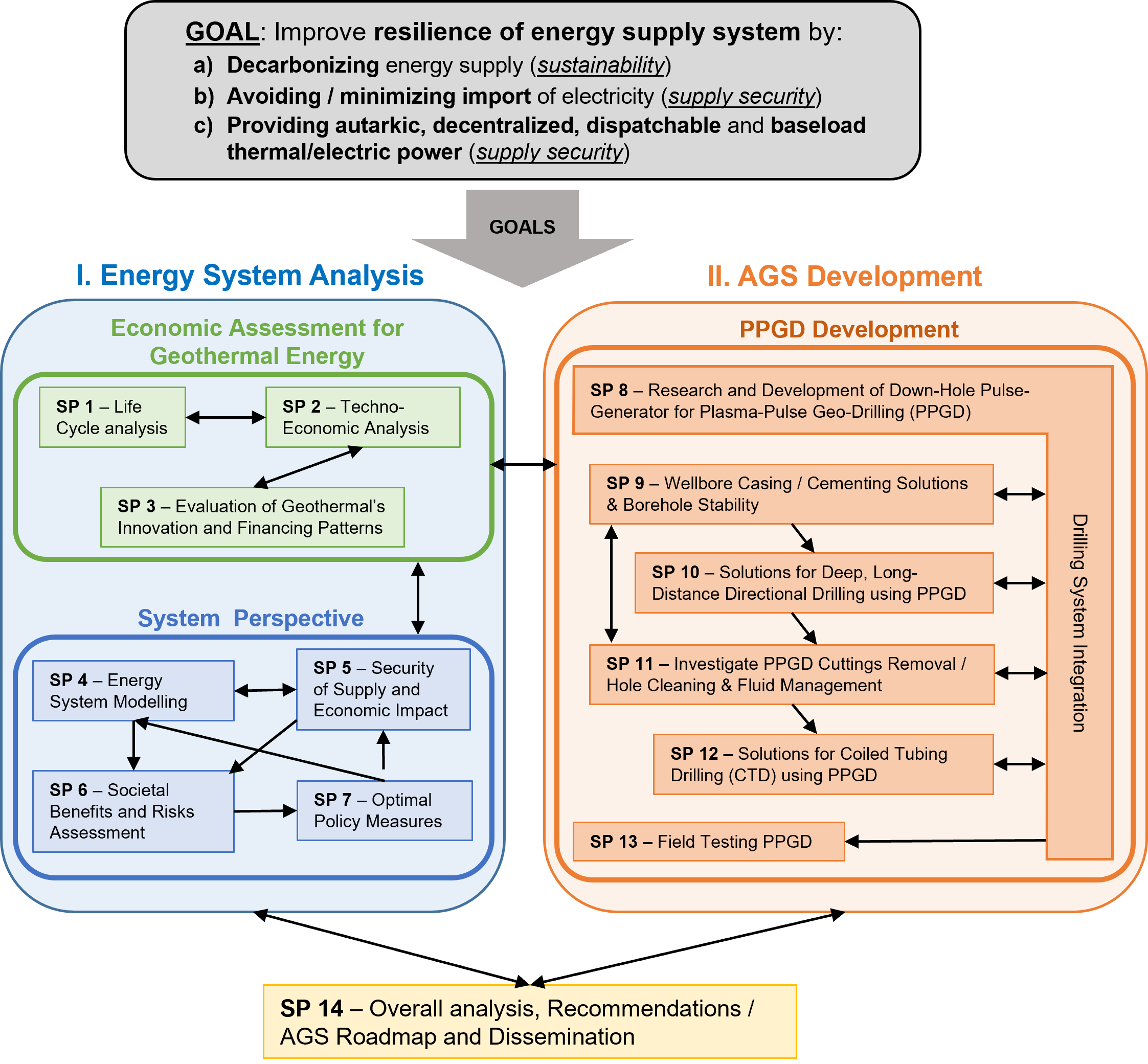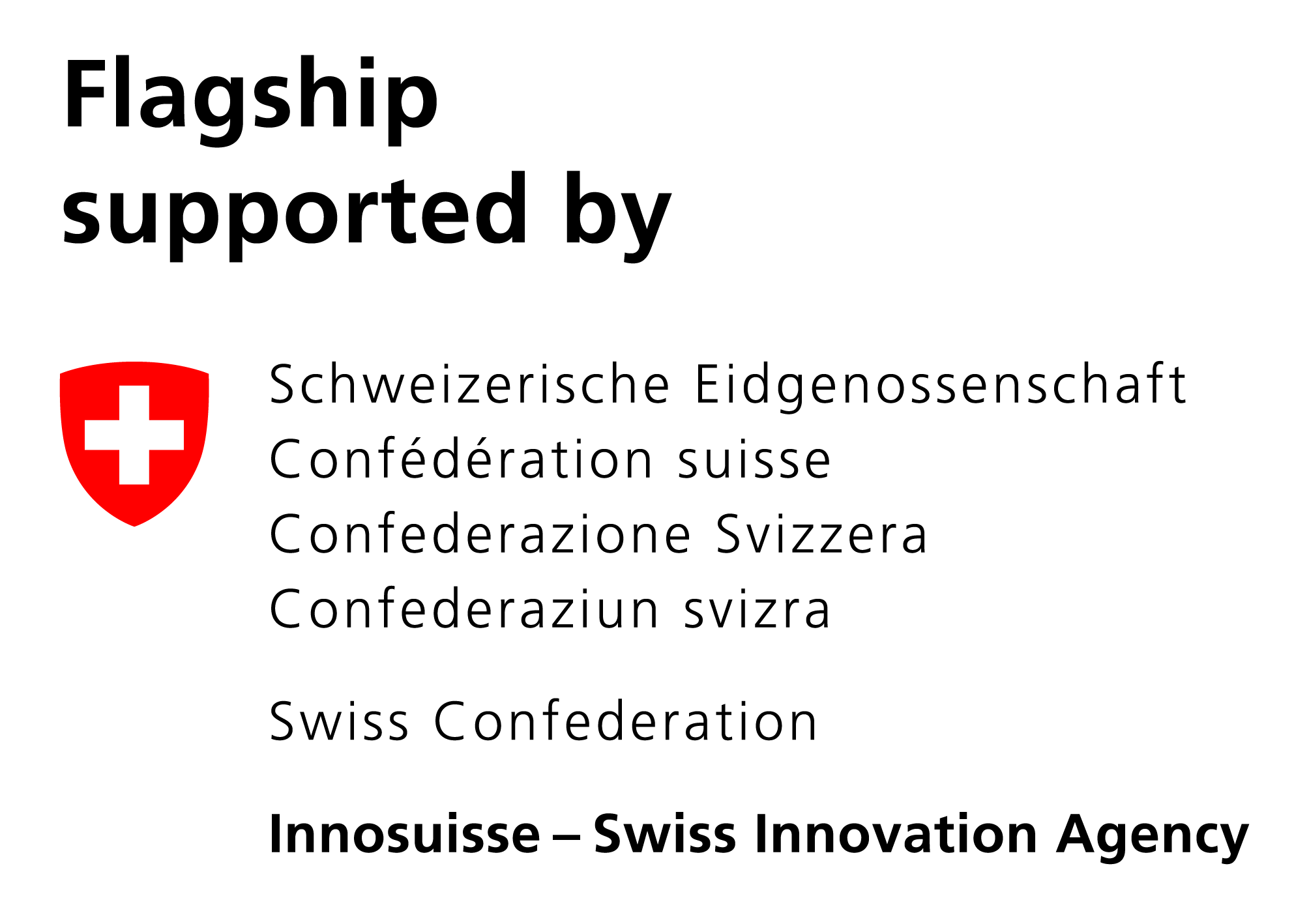Insights
Introduction
AEGIS-CH proposes achieving a resilient Swiss energy supply system (SESS) by reducing/avoiding energy imports, analyzing optimal energy mixes and deriving policy recommendations for 2050, considering all primary energy sources (5 renewables + 2 non-renewables). Specifically, a resilient SESS by developing and including an autarkic, decentralized and largely location-independent power generation system (closed-loop Advanced Geothermal Systems – AGS) is focused on this project.
AGS
Advanced Geothermal Systems (AGS) are a novel geothermal energy (GE) technology, where a working fluid circulates in a deep, closed well loop to collect heat by conduction with the surrounding hot rock [[1],[2]]. At the surface, the extracted heat is used to generate electric/thermal power. AGS target comparable depth and temperature levels as Enhanced Geothermal Systems (EGS). EGS make use of hydraulic stimulation (hydraulic fracturing and/or shearing) of the reservoir rock to artificially enhance its (naturally low) permeability. Hydraulic stimulation operations are causing, by definition, at least small earthquakes. In contrast to EGS, AGS do not require such hydraulically stimulated permeability enhancements by e.g. “fracking”.
The upper figure (modified from [3]) compares the differences in layouts, constructions, and target depth of conventional hydrothermal systems (a), EGS (b) and AGS (c).
AGS can generate dispatchable and baseload power, without operational CO2 emissions. Moreover, the ubiquitous source of geothermal energy and the geology-independence of AGS enable CO2-emission-free, decentralized, autarkic energy supply, avoiding expensive power grids. Also, AGS have little external costs/impacts, further benefiting their long-term social and environmental sustainability
AEGIS-CH: Holistic Approach
The “Energy System Analysis” aims at performing a holistic investigation of the Swiss energy system that includes all primary energy sources, the renewables (Wind, Solar, Hydro, Biomass and Geothermal) and the non-renewables (Fossil and Nuclear). However, geothermal energy systems in general and AGS in particular have only rudimentarily been included in this analyses. Thus, the “Economic Assessment” cluster (SP 1-3) enables proper inclusion of all modern geothermal energy technologies in such energy systems, including the here further to be developed AGS technology (see SP 8-13 below). To address this holistically, we consider the environmental, techno-economic and ecological aspects of the Swiss energy supply system (SESS).
The “System Perspective” cluster (SP 4-7) then addresses the overall energy mix scenarios for Switzerland, where all primary energy sources with proper integration of geothermal energy technologies and in particular AGS may be included as long as the SESS optimization goals are reached. This cluster will deliver the benefits and overall risk of the energy mix scenarios and derive potential policy measures to motivate and steer the market.
In the “AGS Development” cluster (SP 8-13), a key aspect is the development of a significantly cheaper drilling technology based on novel Plasma-Pulse Geo-Drilling (PPGD) technology. A major component of this development is the down-hole pulse-generator (DHPG) in SP 8 which aims to integrate the pulsed plasma system in the bottom hole assembly. In addition, the entire PPGD drill system and drilling process need to be investigated, developed, and tested including specific casing/cementing solutions, borehole stability assessments (SP 9), directional drilling solutions (SP10), cuttings removal/fluid management (SP 11), coiled tubing drilling options (SP 12) and finally field testing (SP 13). Hence, the complete drilling process with novel PPDG technology and the complete drilling system is focused in the “AGS Development” cluster.
The overarching goal is to provide recommendations and roadmaps for the Swiss energy supply system (in SP 14), according to specified (Swiss Energy Transition 2050 and supply security) goals, such as no operational CO2 emissions, ensure supply security and limited/no energy imports.
References
[1] Malek, A. E, Adams, B. M., Rossi, E., Schiegg, H. O., & Saar, M. O. (2021). Electric Power Generation, Specific Capital Cost, and Specific Power for Advanced Geothermal Systems (AGS). In: Proceedings of the 46th Workshop on Geothermal Reservoir Engineering, Stanford, CA. doi: 10.3929/ethz-b-000467172
[2] Van Oort, E., Chen, D., Ashok, P., & Fallah, A. (2021). Constructing Deep Closed-Loop Geothermal Wells for Globally Scalable Energy Production by Leveraging Oil and Gas ERD and HPHT Well Construction Expertise. In: SPE/IADC International Drilling Conference and Exhibition, Virtual, March 2021. doi: 10.2118/204097-MS
[3] Rangel-Jurado, N. (2021). Thermal performance evaluations of fractured and closed-loop geothermal reservoirs, MSc Thesis, 88 pp, Cornell University, USA.

Geothermal Energy generation technologies: (a) hydrothermal, (b) Enhanced Geothermal System (EGS) and (c) the novel deep closed-loop Advanced Geothermal Systems (AGS), figure modified from [3].

Flow chart of AEGIS-CH highlighting the various focus areas of the project with arrows indicating interdependencies among subprojects (SP). Left: Energy System Analysis Cluster: Analysis and recommendations concerning optimized energy mix scenarios for Switzerland including all modern geothermal energy systems. Right: AGS Development Cluster: Development and Integration of plasma pulsed drilling technology in a complete drilling system for deep, directional wells.




